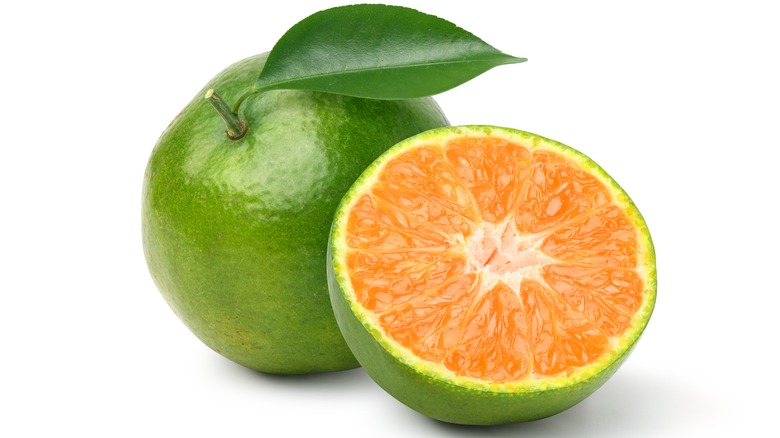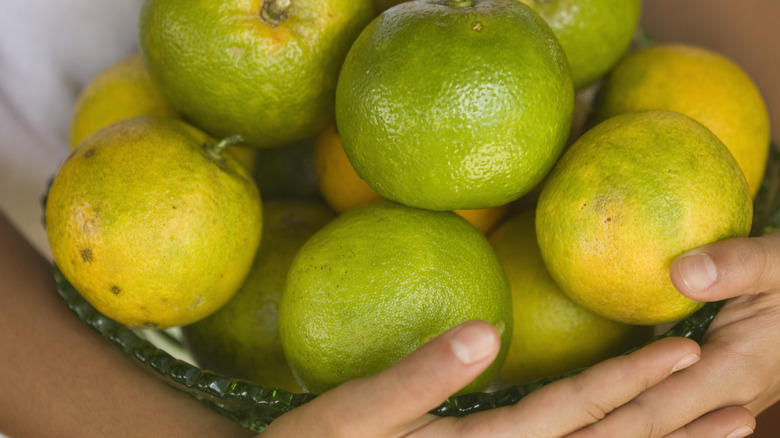Can You Tell If Orange Peels Have Been Artificially Dyed?
It's one of the first things you learn in preschool: the sky is blue, the grass is green, and oranges are orange.
While your preschool teacher wasn't exactly wrong, oranges aren't always orange: they're often green. Green oranges aren't necessarily unripe, and they aren't some special variety. The oranges that you see in the grocery store — yes, the ones that look orange — don't always get that way naturally. For decades, citrus growers have dyed their produce bright orange to appeal to customers.
Naturally, oranges vary in color based on the climate where they're grown. Oranges grown in tropical climates grow green year-round, even when they're fully ripe. The green skin comes from chlorophyll, which acts as a sort of natural sunscreen. When nights turn cold, the oranges start to lose their color — just like fall leaves. Open a green orange up and you'll find that the insides are still a bright orange color, just as sweet and flavorful as the oranges that you're used to.
The United States Food and Drug Administration (FDA) allows growers to dye oranges, either through a process that degrades the chlorophyll by exposing it to ethylene gas, or by dying the oranges with a dye called Citrus Red No. 2. While the FDA rules that Citrus Red No. 2 is safe for this purpose, concerns about the dye have existed since the 1970s. Health-conscious consumers — or anyone who wants to stay well-informed about the food they eat — can benefit from learning more about the practice.
Are dyed oranges safe to eat?
The International Agency for Research on Cancer lists Citrus Red No. 2 as a group 2B carcinogen, a classification for substances that may cause cancer. While the dye hasn't been tested on humans, it has been shown to produce tumors in rats and mice.
However, research published by the Florida State Horticultural Society maintains that the amount of Citrus Red No. 2 used to color oranges isn't enough to cause serious harm. According to the article, "The Color-Add Process as Applied in Florida," the rats and mice in the original study were fed far more Citrus Red No. 2 than even the most voracious orange-eater would encounter. The dye stays on the peel rather than penetrating through to the flesh of the fruit, and even if you were to eat significant amounts of orange peel, the actual amount of dye that you'd consume would be minimal. Estimates suggest that a human would have to eat the peel of 2,200 pounds of oranges every day to have an effect.
Researchers are still searching for a solution using natural dyes, but a 2015 study suggested that dye derived from annatto extract could be a viable alternative to Citrus Red No. 2.
How to identify dyed oranges
Despite evidence that the amount of Citrus Red No. 2 used to dye oranges isn't enough to cause harm to humans, it's natural for customers to be wary. So what are your options?
According to the FDA, retailers are required to inform customers if their oranges have been dyed, either by displaying "the labeling of the bulk container plainly in view" or with "a counter card, sign or other appropriate device bearing prominently and conspicuously the fact that the oranges are artificially colored." But despite the FDA's regulations, it might not be immediately obvious whether or not the fruit has been dyed — and even if it is, finding unadulterated oranges might be easier said than done.
For your best bet, shop organic. Local farmer's markets might have better options than big box stores, and you may be able to get first-hand information on how the fruit was grown. You can also seek out oranges produced in California or Arizona since both states banned the use of Citrus Red #2.
Forgoing brightly colored oranges for fruits with dingy, yellow-green peels might seem counterintuitive, but remember that color is a poor indicator of quality, even if the fruit hasn't been dyed. Instead, look for other indicators: A quality orange should be heavy for its size with a strong, sweet scent. Different types of oranges come into season at different times of the year, so check to see what's available.


